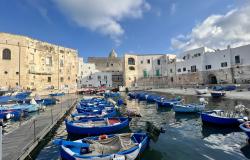We can never write enough about Abruzzo and its many beautiful places. Save these ideas for your next trip!
Rocca Calascio
Standing atop a hill at 1,460 meters (4,790 ft) above sea level, the 13th-century Rocca Calascio is the highest fortress in the Apennines, the mountain chain that runs through the length of Italy.
Rocca Calascio was never intended as a noble residence; it was built for military purposes and to accommodate troops, as evident from its architecture and design. Built of stone and masonry, its lower half features larger stones than its upper half, probably to make the base unassailable. The fortress, however, was never used in a battle. It was instead badly damaged by a powerful earthquake in 1481.
Owners of the Rocca included the Medici of Tuscany.

From the fortress, the view is spectacular as you admire the Corno Grande peak of the Gran Sasso mountain, and the 17th-century Church of Santa Maria della Pietà just below.
Because of its spectacular position and views, Rocca Calascio has been used to film scenes for a number of movies, including Ladyhawke, The Name of the Rose and The American.
Basilica of Santa Maria di Collemaggio
A masterpiece of Abruzzese Romanesque and Gothic architecture, the Basilica of Santa Maria di Collemaggio is L’Aquila’s most important church and the largest in Abruzzo. It was heavily damaged during the 2009 earthquake that devastated the city, which is the regional capital of Abruzzo.
The Basilica was built in 1287, and, a few years later, in 1294, Celestine V was crowned pope inside, and later buried there. The façade resembles a wall, and its peculiarity is the pattern of blocks of alternating pink and white stone, arranged in a sort of tapestry. Each of the three doors, one central and two smaller ones to the side, is surmounted by a rose window. The interior is grand and austere.
The Basilica underwent a €14 million restoration after the earthquake, privately financed.
Scanno
Some call it the ‘pearl of Abruzzo’, and Scanno surely is a beautiful village, surrounded by the Majella mountains, in the National Park of Abruzzo.
Stroll the alleys and visit the artisans’ shops; especially renowned are the lace and goldsmith workshops, where the local jewel ‘presentosa’ is still made. Try the ‘pan dell’orso’, a traditional dessert, then head to the lake, which, seen from above, looks like the shape of a heart. According to legend, Scanno's natural lake was created by a feud between a white witch and a sorcerer; the lake marks the spot where the witch fell.

Fun fact: Scanno has been photographed by several world-famous photographers, including Henri Cartier-Bresson, Elliot Erwitt, Gianni Berengo Gardin and Mario Giacomelli, whose photo, Il Bambino di Scanno (Scanno’s Child) is exhibited at the Moma in New York.
Stiffe Caves
Among the most spectacular examples of karst caves in Italy are the Grotte di Stiffe, near L’Aquila, which formed about 600,000 years ago, produced by an underground river that emerges on the surface.
They are more than a kilometer long and are not fully explored yet.
It is possible to visit the caves following a tourist route of about 700 meters that concludes at a waterfall. Along the way you can see big stalactites and stalagmites, black lakes, rushing streams. It really is quite spectacular.
Make sure to wear warm clothes as the temperature inside stays at a constant 10°C all year round.
Costa dei Trabocchi
Trabocchi are large, spider-like fishing platforms, made of wood, ropes and nets, found along the coast of Abruzzo. These structures unique to Abruzzo were invented in the 18th century to allow farmers to hunt for fish without having to face the dangers of the open sea.
The Trabocchi Coast corresponds to the Adriatic stretch that goes from Ortona to San Salvo for about 70 kilometers and is where you will find the most trabocchi, along with typical little towns that have preserved their ancient traditions.
The most beautiful beaches along the coast include Punta Aderci, Punta Penna, Punta d’Acquabella, Calata Turchino and Punta Cavalluccio. Some trabocchi have been turned into restaurants where you can try the local cuisine.

Eremo di San Bartolomeo in Legio
The hermitage of San Bartolomeo in Legio is located on a rocky spur 700 meters above sea level in the Majella, not far from another hermitage place, Santo Spirito a Majella.
San Bartolomeo dates back to before the 11th century and was restored by Pietro dal Morrone, the future Pope Celestino V, around 1250. Celestino himself lived there around 1274 for at least a couple of years.
The hermitage consists of a chapel and two rooms carved into the rock intended for the hermits. Access is via four different stairs, also carved into the rock.

The facade of the church shows traces of severely damaged frescoes.
If you need a break from the madness and the noise, this is the place!
Piccolomini Castle
In the wild heart of the Marsica, stop by Celano for a taste of history and nature. First, walk the streets of the historic center and visit the fairytale medieval Piccolomini Castle, which overlooks the Fucine plain. The castle dates back to the Middle Ages, and was built for defensive purposes.
Afterwards, head to the Gorges of Aielli-Celano, some of the most important canyons in Abruzzo and Italy, with a deep valley carved out by the La Foce stream and spectacular rock walls that can be up to 200 meters high. Look out for golden eagles, kites and griffins, which nest in the canyon.









